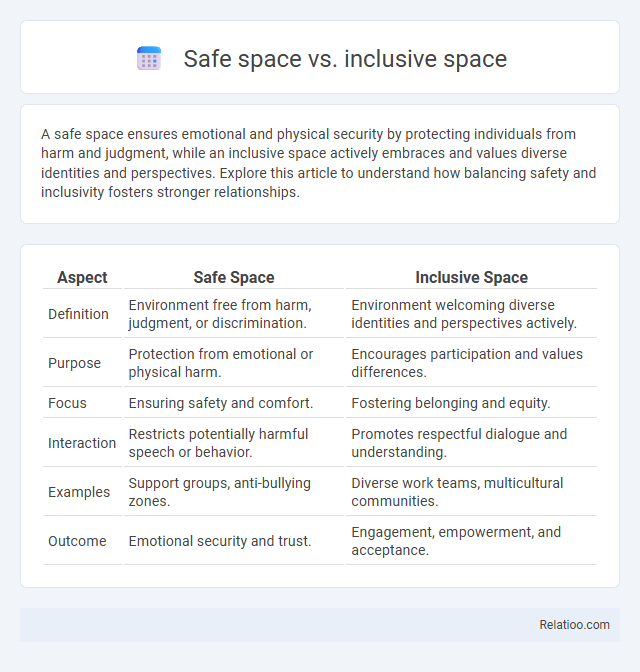A safe space ensures emotional and physical security by protecting individuals from harm and judgment, while an inclusive space actively embraces and values diverse identities and perspectives. Explore this article to understand how balancing safety and inclusivity fosters stronger relationships.
Table of Comparison
| Aspect | Safe Space | Inclusive Space |
|---|---|---|
| Definition | Environment free from harm, judgment, or discrimination. | Environment welcoming diverse identities and perspectives actively. |
| Purpose | Protection from emotional or physical harm. | Encourages participation and values differences. |
| Focus | Ensuring safety and comfort. | Fostering belonging and equity. |
| Interaction | Restricts potentially harmful speech or behavior. | Promotes respectful dialogue and understanding. |
| Examples | Support groups, anti-bullying zones. | Diverse work teams, multicultural communities. |
| Outcome | Emotional security and trust. | Engagement, empowerment, and acceptance. |
Defining Safe Spaces
Safe spaces are environments where individuals feel protected from discrimination, harassment, and harm, allowing them to express themselves without fear of judgment or exclusion. Inclusive spaces actively embrace diversity and ensure equitable participation by recognizing and valifying different identities, cultures, and perspectives. Your understanding of safe spaces should highlight their role in fostering emotional security, setting clear boundaries, and promoting respect for personal experiences.
Understanding Inclusive Spaces
Inclusive spaces prioritize diversity, equity, and authentic belonging by actively embracing differences and fostering mutual respect among all participants. Unlike safe spaces, which primarily aim to protect individuals from harm or discomfort, inclusive spaces encourage open dialogue and challenge biases to promote growth and understanding. The core of inclusive spaces lies in creating environments where every voice is valued and systemic barriers are acknowledged and addressed.
Key Differences Between Safe and Inclusive Spaces
Safe spaces prioritize physical and emotional safety, protecting individuals from discrimination, harassment, or harm, while inclusive spaces emphasize active participation, respect, and representation of diverse identities. Key differences include safe spaces often limit certain speech or behaviors to prevent distress, whereas inclusive spaces encourage open dialogue and collaboration among varied perspectives. Both concepts aim to foster belonging, but safe spaces focus on protection, and inclusive spaces focus on engagement and equity.
The Purpose of Safe Spaces
Safe spaces provide environments where individuals can express themselves without fear of discrimination or harm, prioritizing emotional and physical safety. Inclusive spaces go beyond safety by actively encouraging diversity, equity, and participation from all individuals, fostering a sense of belonging. Your understanding of safe spaces emphasizes their foundational purpose: to protect vulnerable groups and ensure comfort and security in challenging or marginalized settings.
The Goals of Inclusive Spaces
Inclusive spaces prioritize creating an environment where diverse identities are actively welcomed, respected, and represented, fostering equality and belonging for all participants. The goal of inclusive spaces is to dismantle barriers related to race, gender, sexuality, ability, and other social differences, allowing everyone to contribute freely without fear of exclusion or marginalization. Unlike safe spaces, which primarily emphasize protection from harm, inclusive spaces focus on proactive engagement, representation, and equitable participation across all community members.
Challenges in Creating Safe Spaces
Creating safe spaces involves overcoming challenges such as addressing power imbalances, ensuring trust, and managing diverse emotional needs, which can be difficult to balance effectively. Inclusive spaces require intentional efforts to represent and respect all identities, but may encounter resistance due to unconscious bias and systemic barriers. You must navigate these complexities carefully to foster environments where everyone feels both safe and included.
Barriers to Building Inclusive Spaces
Barriers to building inclusive spaces often stem from implicit biases, lack of awareness, and resistance to change, which can create challenges even in spaces labeled as safe or inclusive. While safe spaces prioritize protection from harm and discrimination, inclusive spaces emphasize active participation and representation of diverse identities, requiring intentional efforts to dismantle systemic obstacles. You must address these barriers by fostering empathy, education, and open dialogue to ensure genuine inclusivity beyond mere safety.
Balancing Safety and Inclusion
Balancing safety and inclusion requires creating environments that protect individuals from harm while actively embracing diverse identities and perspectives. Safe spaces prioritize emotional and physical security, often limiting potentially triggering content to maintain comfort. Inclusive spaces encourage open dialogue and respect, fostering a sense of belonging by accommodating differing views and experiences without compromising safety.
Impacts on Community and Belonging
Safe spaces prioritize protecting individuals from harm and discrimination, fostering an environment where Your identity is respected and you feel secure. Inclusive spaces actively promote diversity and equitable participation, encouraging all community members to contribute and feel valued. The intersection of safe and inclusive spaces enhances community belonging by combining emotional safety with acceptance, empowering individuals to thrive collectively.
Best Practices for Fostering Both Spaces
Creating both safe and inclusive spaces requires implementing active listening, empathy, and respect for diverse perspectives to ensure everyone feels valued and heard. Your commitment to clear communication, zero-tolerance policies against discrimination, and continuous education on bias and cultural competence strengthens trust and psychological safety. Encouraging collaboration and feedback helps maintain environments where individuals can express themselves authentically without fear of judgment or exclusion.

Infographic: Safe space vs Inclusive space
 relatioo.com
relatioo.com